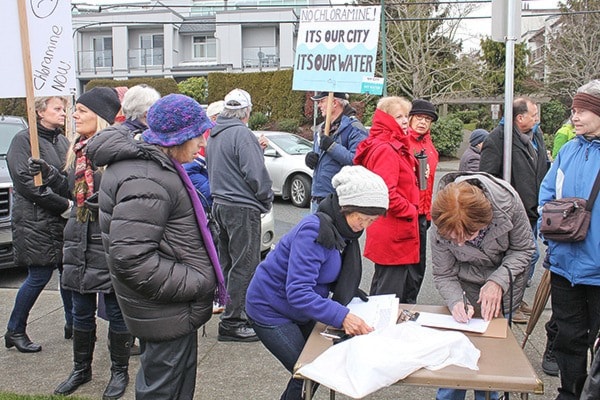White Rock city council voted to halt plans to treat the city’s water supply with chloramine, after a lengthy, lively discussion on disinfection options Monday.
The unanimous vote came after presentations from Fraser Health officials who provided background on why the city has been directed to implement a secondary treatment plan by June 30, as well as responses to some of the health concerns raised by residents in recent weeks.
The decision also came several hours after 170 residents rallied on the lawn of city hall, calling on officials to rethink plans to treat the water with chloramine – a mixture of chlorine and ammonia.
The council motion, tabled by Coun. Bill Lawrence, calls for staff to request a postponement of the June 30 treatment deadline from Fraser Health, and to utilize chlorination, not chloramination, as a means of secondary disinfection.
Despite assurances from Fraser Health’s medical health officer Dr. Michelle Murti that chloramination presents no negative health effects, nor does it pose infrastructure concerns if it’s properly monitored, council echoed many of the concerns raised by residents.
“I just don’t feel that there’s enough data and enough research to be able to feel comfortable with keeping (chloramine) on,” Lawrence said, garnering applause from the overflow crowd.
Mayor Wayne Baldwin said that while he felt much of the fear surrounding the issue “isn’t grounded,” he did have concerns about the potential environmental impact on the Little Campbell River, to which one of the city’s storm-sewer drains travels.
“It is not acceptable for us to allow chloraminated water to go into the Campbell River, which is part of Semiahmoo traditional grounds,” Baldwin said, making note of SFN band councillor Joanne Charles in the audience. “It is their water, in essence, and it would be disrespectful for us to create an environmental situation on their traditional grounds.”
David Riley, a director of the Little Campbell Watershed Society who spoke of the environmental risks of chloramine at the noon-hour rally Monday, told Peace Arch News Tuesday that the council vote was a “positive development” but that “the debate still needs to be broadened.”
“Obviously, council listened to some segments in the community, and they’re taking a second look at things, and I think that’s positive,” Riley said. “It’s up to the rest of the community to tell city hall that we want more public dialogue.”
Prior to council’s discussion on the topic, Murti and Fraser Health’s environmental health officer Lloyd Struck spoke about the authority’s disinfection requirements, which stemmed from the discovery of traces of E.Coli in the water supply in 2010, which forced the city to enforce a boil-water advisory.
Murti told council that although Fraser Health has no preference between chlorination or chloramination, there are some advantages to using chloramine to treat the city’s 120 kilometres of pipeline.
“A free chlorine residual has a shorter half-life than a monochloramine, (which) stays longer within a system,” Murti said. “If you consider the amount of residual time the water spends in a distribution tank and through the pipeline, that’s a long time and very difficult to maintain the free chlorine residual that’s required at the end of the tap.”
Murti described White Rock’s system as “an aging infrastructure,” noting the city has “been lucky” to have had no other bacteria incidents prior to the 2010 E.Coli scare.
“The reservoirs are not as solid as they were when they were first built, the pipelines are not as clean,” she said.
Struck made reference to the city’s “temporary setup,” which includes the addition of chlorine at wells six and seven at the Merklin Street reservoir, noting that even with that treatment in place, testing over the summer revealed “some total coliform results.”
“We’ve been waiting patiently for you guys to get secondary treatment in place,” Struck said. “We’re really quite anxious to get this done.”
Addressing questions about how the city plans to treat the water for arsenic and manganese – which officials said were nearing the highest allowable levels – city staff invited consultant Dr. Bartek Puchajda, who has been involved with the design of upgrades, to speak.
Puchajda said that because the levels were still within an acceptable range, “the decision was made to monitor the situation,” and that implementation of a treatment plan would take 24 to 36 months.
He made reference to “bench scale tests” undertaken by Epcor prior to the utility’s sale to the city which resulted in “very noticeable” reactions with chlorine, which would lead to staining of plumbing as well as a foul odor and taste.
“We concluded that in the long-term, it would be unacceptable to provide water of this quality to the residents,” Puchajda said.
Prior to voting, Baldwin made reference to the “public angst” in the community surrounding the plans.
“Had the city not taken on the purchase of the water utility, all this would have happened by now. You’d be drinking chloraminated water and you wouldn’t know it,” he said. “The fact is, we are going through a public process, we’re discussing it publicly and you’re learning about it publicly.”
